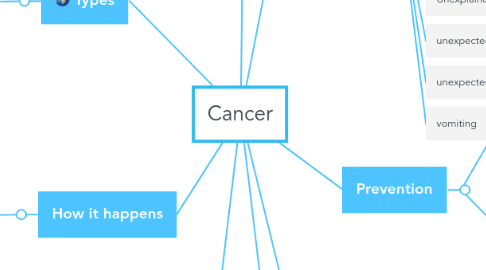Cancer
von Samantha Patone


1. Problems
1.1. Death
1.2. Approximately 39% of men and women are diagnosed with cancer during their lifetime.
2. What it is
2.1. the disease caused by an uncontrolled division of abnormal cells in a part of the body
3. Types
3.1. There are over 100 types of cancer including:
3.1.1. Lung Cancer
3.1.2. Bladder Cancer
3.1.3. Breast Cancer
3.1.4. Brain Cancer
3.1.5. Cervical Cancer
3.1.6. Bone Cancer
3.1.7. Eye Cancer
3.1.8. Skin Cancer
3.1.9. Kidney Cancer
4. How it happens
4.1. Cancer is a genetic disease—that is, it is caused by changes to genes that control the way our cells function, especially how they grow and divide.
5. Causes
5.1. Some Common Causes:
5.1.1. Smoking and Tobacco
5.1.2. Viruses and Infections
5.1.3. The sun and other types of radiation
5.1.4. Bad diet and physical activity
5.1.5. Certain lifestyle choices are known to increase your risk of cancer. Smoking, drinking more than one alcoholic drink a day (for women of all ages and men older than age 65) or two drinks a day (for men age 65 and younger), excessive exposure to the sun or frequent blistering sunburns, and being obese can contribute to cancer.

